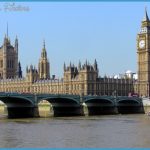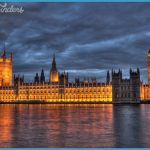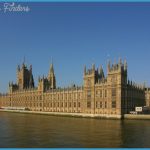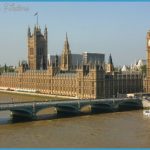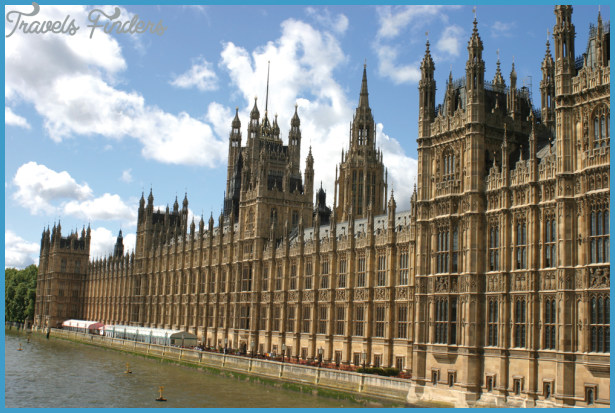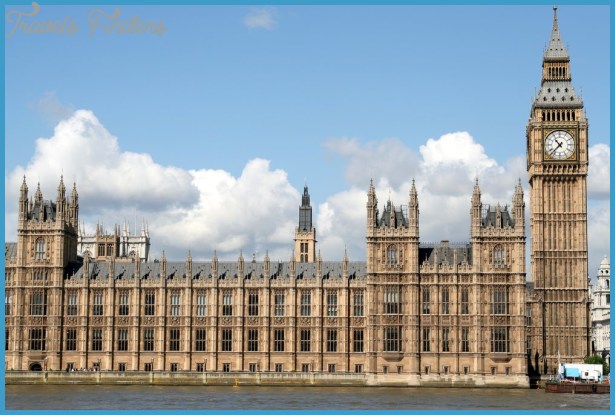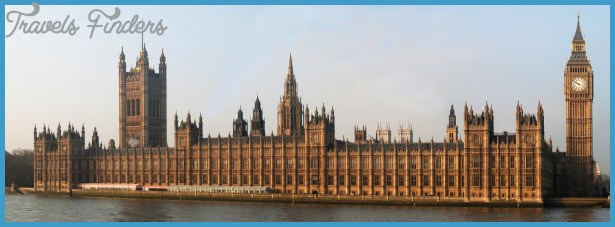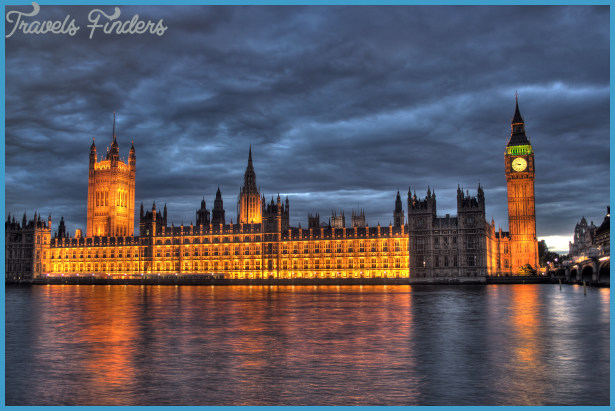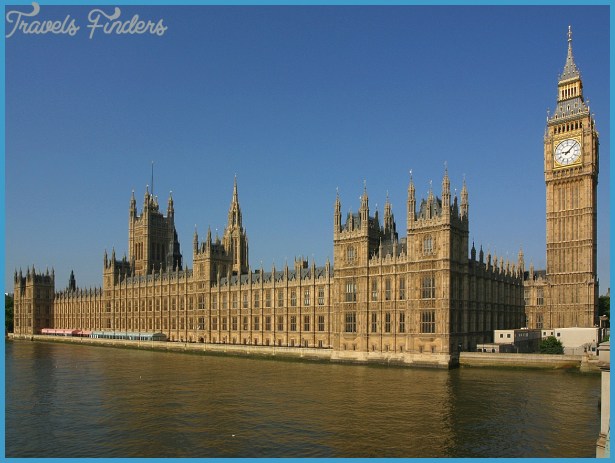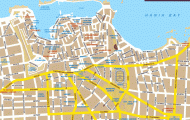CHARLES BARRY AND AUGUSTUS WELBY NORTHMORE PUGIN
Work on Britain’s Houses of Parliament, also known as the Palace of Westminster, began after the previous building had been almost totally destroyed in a devastating fire. The winner of the competition to design the prestigious new building was the experienced architect Charles Barry, whose victory was due in part to an impressive set of drawings by A. W. N. Pugin, his younger colleague. Pugin made a huge contribution to the design of both the exterior and interior, which continued to evolve over the 30-year construction period. The competition brief specified a building in the Elizabethan or Gothic style.
Barry’s and Pugin’s design is a version of Gothic influenced by the English churches of the 15th century and the domestic architecture of the Tudor period. It combines a long, horizontal river fagade of repeating windows with a forest of vertical pinnacles and turrets and two graceful towers-the huge Victoria Tower and the soaring Clock Tower (largely Pugin’s work), which soon became the most famous landmark in London.
This vast building contains hundreds of rooms, which the architects planned with great care. Running down the center is a “spine of large rooms-the Lords and Commons debating chambers and their lobbies, arranged on either side of the spacious Central Lobby. At one end of them, next to the House of Lords, is the Royal Gallery, a large state reception room. Corridors off the spine lead to offices for the Members of Parliament, committee rooms, and service rooms. The architects used the latest technology, and the building has a ventilation system way ahead of its time-many of the apparently ornamental turrets are air vents.
Pugin, the foremost Gothic Revival designer of the era, was responsible for the decorative details that make this building so special-from moldings to wallpapers, furniture, door handles, and ink stands. The interiors that best exemplify his flair are the most ornate in the building-the Robing Room and the House of Lords-in which rich gilded woodwork and deep-red upholstery combine to luxurious effect. These lavish interiors are a reminder that, although Barry won the competition and produced the overall plan, Pugin made the plan work and turned the building into a national symbol.
CHARLES BARRY AND A. W. N. PUGIN
Charles Barry was one of the most prolific architects of the 19th century. As a young man he traveled widely, visiting not only France and Italy, but also Jerusalem and Damascus. He was drawn to the classical and Renaissance styles but also designed some Gothic-style churches at the beginning of his career. He is, however, most famous for a series of secular buildings London clubs, civic buildings, and large country houses. These projects prepared him for the large-scale planning needed for the Houses of Parliament.
Pugin was totally committed to the Gothic style. A Catholic convert, he was fascinated by the Middle Ages and was convinced that this period represented the best in European life and architecture. He is especially known for his Catholic churches, but he also designed a number of schools, houses, and other buildings. His love of traditional craft skills and the emphasis he placed on unpretentious design was to have a powerful influence on the architects of the late 19th-century Arts and Crafts movement.
Visual tour
2 CLOCK TOWER Designed by Pugin, this tower is a refined version of the one he had designed for Scarisbrick Hall, a country house in Lancashire, and contains the famous bell known as Big Ben. Pugin placed the tower at one end of the building, with no surrounding structures, so that the vertical focus of the stonework, buttresses, and windows is visible all the way up, emphasizing its height. At the top the pyramidal roof, broken into two parts, elongates the tower further. The finials (roof ornaments) and other details add a whimsical touch.
The central tower was originally designed as a chimney and air vent
2 VICTORIA TOWER
The large tower at the southwestern end of the building housed the ceremonial royal entrance and had space for the parliamentary archives above. The massive structure and the weighty contents of the archive are supported by an iron framework, concealed beneath the beautifully decorated stone fagade.
As well as the intricately detailed tall windows in the late-medieval Perpendicular Gothic style are numerous statues, standing in niches under ornate stone canopies.
2 TOWERS AND TURRETS
Dozens of pinnacles, finials, and turrets enliven the skyline of the Houses of Parliament. Pugin designed all of these to be highly decorarative, with ogees (double curves), carved crockets (curved, leaflike decorations running up the edges of spires and roofs), and other features.
These forms of ornament appear all over the building, both on the towers and along the main fagades, giving it interest and variety reminiscent of one of the great medieval cathedrals.
The Royal Gallery is used for ceremonies when both houses of Parliament are present
St. Stephen’s doorway is the main public entrance
The hammer-beam roof of Westminster Hall is a masterpiece of medieval carpentry
This doorway is the ceremonial entrance to the building
3 ST. STEPHEN’S HALL The public entrance to the Houses of Parliament opens into this vast Gothic hall, which leads to the Central Lobby. Built on the site of St. Stephen’s Chapel, this large meeting space formed part of the medieval Palace of Westminster. It is roofed with a lierne vault a type of late medieval stone vault with a very complex pattern of ribs and is lit with rows of stained-glass windows.
1 CENTRAL LOBBY The Central Lobby is a large octagonal room in the heart of the building, at the midpoint of the central spine, with the two debating chambers and their lobbies on either side. It is a tall space, rising through several stories of the building and topped with a stone vault. The vault’s starlike pattern is similar to that seen on the ceilings of the chapter houses of medieval cathedrals.
2 HOUSE OF LORDS The Lords’ debating chamber is a high, spacious room, richly furnished with red leather seats and decorated with gilding. Unlike the Commons chamber, which suffered bomb damage during World War II, the Lords retains most of its original features. The focal point is the huge canopy and throne on which the monarch sits to address Parliament.
IN CONTEXT
The Houses of Parliament are built on the site of the medieval Palace of Westminster, a former royal residence that became the meeting place of Parliament when democratic government evolved in England. When most of this building was burned down in 1834, only one substantial part escaped the flames the room now known as Westminster Hall. This vast chamber, some 240ft (73m) in length, was the heart of the old palace and the scene of royal banquets and state occasions.
It was originally built in 1097 but owes its present appearance to the magnificent hammer-beam roof, begun in 1393 under Richard II. The work of mason Henry Yevele and carpenter Hugh Herland, the roof is a combination of broad wooden arches and protruding hammer beams, supported by stone buttresses built by Yevele. This form of construction enabled Herland to span the room’s 60ft (20.7m) width without using posts or columns an amazing achievement at the time. The hall sits on the southern side of the present building.



